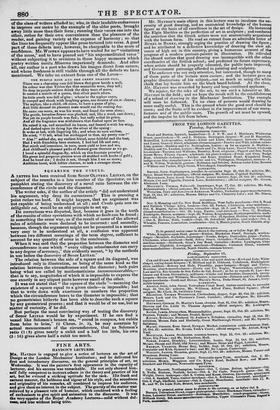SQUARING THE CIRCLE.
A LETTER has been received from Senor OLIVERA LEITAO, on the subject of the remarks in a late number of the Spectator, on his pamphlet stating the discovery of a novel ratio between the cir- cumference of the circle and the diameter.
The writer asks, if the author of the article "did not understand his argument, why deny its correctness?" This is pressing a point rather too hard. It might happen, that an argument was not capable of being understood at all ; and Credo qv& non in- telligibile eat, would be an odd principle to set up. Its correctness was disputed, first, because it goes in the teeth of the results of other operations with which no fault can be found ; in something the same way, as if the result of some of the allowed rules of arithmetic were declared to be incorrect : and secondly, because, though the argument might not be presented in a manner very easy to be understood at all, a confusion was apparent between two different meanings of the term degree, sufficient to account for any quantity of error in the conclusion. When it was said that the proportion between the diameter and circumference is one which "every village schoolmaster can carry to any degree of accuracy," this evidently meant, "by the methods in use before the discovery of Senor LEITAO."
The relation between the side of a square and its diagonal, was introduced only in illustration, as being of the same kind as the relation between the circumference and the diameter; both pairs being what are called by mathematicians incommensurables,— that is to say, magnitudes of which it is impossible to express the one exactly in any aliquot parts however small of the other. It was not stated that " the square of the circle"—meaning the existence of a square equal to a given circle—is impossible; but that to write down with exactness in numbers the proportion which the circumference bears to the diameter is impossible; that no geometrieian hitherto has been able to describe such a square by any geometrical process ; and that it would be of no use, but as matter of curiosity, if he did.
But perhaps the most convincing way of testing the discovery of Senor LEITAO would be by experiment. If he can find a vessel like Solomon's brazen sea, " round in compass, ten cubits from brim to brim," (2 Chron. iv. 3), he may ascertain by actual measurement of the circumference, that as Solomon's ratio (1: 3) gives nearly a cubit and a half too little, his own (5: 16) gives above half a cubit too much.


























 Previous page
Previous page